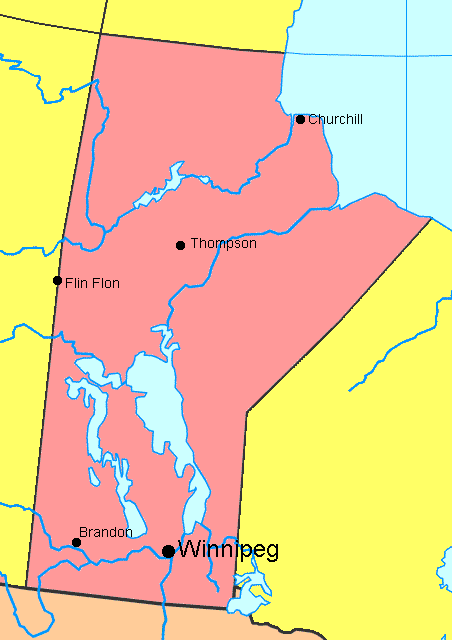|
Manitoba
Manitoba is one of Canada's provinces. It was the fifth province to join Canada (in 1870). Its population as of January 1, 2004 (Statistics Canada) was 1,165,944(Manitobans). It is the easternmost of the three Prairie Provinces. Its capital and largest city (containing over one half the provincial population) is Winnipeg. Other important cities and towns include Brandon, Thompson, Dauphin, Swan River, Churchill, The Pas, Melita, Selkirk, Portage la Prairie, Flin Flon, Steinbach, Morden, and Winkler. Manitoba was settled by members of the Ojibwa and Assiniboine tribes. The first European to reach present-day Manitoba was Sir Thomas Button, who visited the Nelson River in 1612. Pierre Gaultier de Varennes, Sieur de la Vérendrye, visited the Red River Valley in the 1730s as part of opening the area for French exploration and exploitation. An important French-Canadian population (Franco-Manitobains) still lives in Manitoba, especially in the Saint-Boniface district of Winnipeg. The territory was won by Britain in 1763 as part of the French and Indian War, and became part of Rupert's Land, the immense monopoly territory of the Hudson's Bay Company. The founding of the first agricultural community in 1811 by Lord Selkirk, near modern Winnipeg, resulted in conflict between the white colonists and the Métis who lived near there. Twenty colonists, including the governor, were killed by the Métis in the Battle of Seven Oaks in 1816. When Rupert's Land was ceded to Canada in 1869 and incorporated into the Northwest Territories, a lack of attention to Métis concerns led their leader Louis Riel to establish a provisional government. Negotiations between this government and the Canadian government resulted in the creation of the province of Manitoba and its entry into Confederation in 1870. Originally the province was only 1/18 of its current size and square in shape - it was known as the "postage stamp province." It grew progressively, absorbing land from the Northwest Territories until it attained its current size by reaching 60°N in 1912. |
||||||||||
